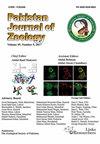Dietary Habits of Indian Gerbil Tatera indica Inhabiting Agro-Ecosystem of Pothwar Plateau, Pakistan
IF 0.5
4区 生物学
Q4 ZOOLOGY
引用次数: 0
Abstract
The Indian gerbil Tatera indica occurs in the Pothwar Plateau and is associated with agro-ecosystem of the area. No particular scientific studies have been focussed on dietary habits of this species in particular Plateau. Therefore, the focal aim of the current study was to investigate the dietary habits of Indian gerbil by using micro-histological analysis of stomach contents in croplands of the Pothwar Plateau and to study the variation in its food composition during cropping and non-cropping seasons. A total of 30 specimens were trapped by using snap traps in wheat, groundnut and adjacent non-crop habitats. Results showed that the gerbil rat was chiefly omnivore; feeding on wheat-groundnut plants and grains as the crops approached maturity, wild flora (viz: herbs, grasses, seeds and tubers) invariably amongst crop stages and seasons. During spring season, wheat was the most frequently consumed cereal. But during winter, as groundnut crop approached towards maturity/harvested, gerbils consumed mainly nuts and grains, while in autumn and summer (non-crop periods), the rat species switched its diet to wild flora, and consumed most frequently Ziziphus nummularia (Beri) followed by Cynodon dactylon (Khabbal grass), Desmostachya bipinnate (Baron dhab), Artemisia dubia etc. along with some fodder crops like Sorghum bicolour (Sorghum), Zea mays (Maize), Brassica campestris (Mustard) etc. The summer diet (non-crop season) was comparatively less diversified than the diet of the cropping season (spring) and there was a significant difference in the diets of this rat species during cropping and non-cropping period. The gerbil also supplemented its diet with insects (animal matters) in higher quantities highlighting its positive role as biological control of insect pests of croplands. Analysis of Variance (ANOVA) later followed by Least Significance Difference (LSD) revealed significant differences during cropping season winter (wheat) and non-cropping season autumn (F = 1.88, df = 18, P < 0.05). The frequency of different food items of cropping and non-cropping season (summer and monsoon) showed the significant difference (F = 1.15, df = 18, P < 0.05) and the remaining unidentified food items were non-significant to each other (F = 1.10, df = 18, P > 0.05). The study concludes that Indian gerbil has got a beneficial role for sustainable agriculture practices.生活在巴基斯坦波特瓦尔高原农业生态系统中的印度沙鼠的饮食习惯
印度沙鼠(Tatera indica)生活在Pothwar高原,与该地区的农业生态系统有关。没有专门的科学研究集中在这个物种的饮食习惯在特定的高原。因此,本研究的重点是通过对Pothwar高原农田胃内容物的显微组织学分析来调查印度沙鼠的饮食习惯,并研究其食物组成在种植季节和非种植季节的变化。在小麦、花生和邻近的非作物生境中采用夹片法捕获30只。结果表明:沙鼠以杂食性为主;当作物接近成熟时,以小麦-花生植物和谷物为食,野生植物(即草药,草,种子和块茎)总是在作物阶段和季节中出现。在春季,小麦是最常食用的谷物。但在冬季,随着花生作物接近成熟/收获,沙鼠主要食用坚果和谷物,而在秋季和夏季(非作物期),沙鼠物种将饮食转向野生植物,最常食用的是紫茎草(Beri),其次是Cynodon dactylon (Khabbal grass), Desmostachya bipinnate (Baron dhab),杜比亚蒿等,以及一些饲料作物,如高粱(Sorghum),玉米(Maize),芸苔(Brassica campstris)等。夏季(非丰收期)日粮的多样性低于春季(丰收期),且该鼠种在丰收期和非丰收期的日粮差异显著。沙鼠还补充了大量的昆虫(动物物质),突出了其作为农田害虫生物防治的积极作用。方差分析(ANOVA)和最小显著性差异分析(LSD)显示,冬季(小麦)种植期和秋季(非种植期)差异显著(F = 1.88, df = 18, P < 0.05)。种植期和非种植期(夏季和季风期)不同食物品种出现频率差异显著(F = 1.15, df = 18, P < 0.05),其余未识别食物品种出现频率差异不显著(F = 1.10, df = 18, P < 0.05)。该研究的结论是,印度沙鼠在可持续农业实践中发挥了有益的作用。
本文章由计算机程序翻译,如有差异,请以英文原文为准。
求助全文
约1分钟内获得全文
求助全文
来源期刊

Pakistan Journal of Zoology
生物-动物学
CiteScore
1.10
自引率
16.70%
发文量
306
审稿时长
4.5 months
期刊介绍:
Pakistan Journal of Zoology (Pakistan J. Zool.) publishes original articles in English on all aspects of animal life. Generally these articles will be in, or related to one of the following subject areas: Physiology, Cell Biology, Molecular Biology, Genetics, Bioinformatics, Toxicology, Forensic Science, Developmental Biology, Entomology, Parasitology, Microbiology, Biotechnology, Pathology, Palaeontology. Taxonomy, Environmental Biology, Wildlife, Fisheries, Vertebrate and Invertebrate Morphology. Additionally, the journal considers research on health and clinical studies. Short communications are regularly considered, however, uninvited review articles, first records/reports of known species, case reports/studies and survey reports are not published in Pakistan Journal of Zoology.
 求助内容:
求助内容: 应助结果提醒方式:
应助结果提醒方式:


